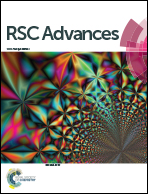Functionalization of AgNWs with amino groups and their application in an epoxy matrix for antistatic and thermally conductive nanocomposites
Abstract
Highly dispersive silver nanowires (AgNWs) in an epoxy matrix were obtained by introducing amino groups onto the surface of AgNWs. Firstly, modification of thioglycolic acid onto the surface of the AgNWs was conducted via coordination bonds between the AgNWs and thiol groups (AgNWs@COOH). Then amido-functionalized AgNWs (AgNWs@NH2) were prepared through an amidation reaction between triethylenetetramine (TETA) and the carboxyl groups. The chemical structure and properties of the AgNW–epoxy nanocomposites were investigated using TEM, EDS, FT-IR, UV, TAG, DSC and SEM. The results revealed that because the amino groups participated in the epoxy curing reaction, chemical bonds were formed at the interface to improve the dispersion of the AgNWs@NH2. Thus, the antistatic and thermal conductivity performances were enhanced by a well-constructed electrostatic discharge channel in the epoxy matrix. The surface resistivity of the AgNWs@NH2–epoxy nanocomposite was decreased to 1.24 × 105 Ω at 0.5 Vt%, and the thermal conductivity coefficient was upgraded to 0.67 W m−1 K−1 at 10 Vt%.


 Please wait while we load your content...
Please wait while we load your content...